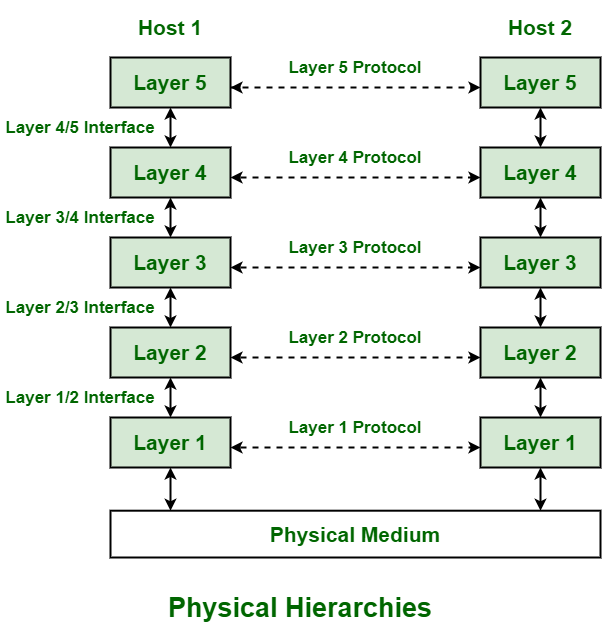Protocol Hierarchies in Computer Network
Last Updated :
12 Mar, 2024
A Protocol Hierarchy is a fixed set of rules and conventions that govern the communication between two or more computers. The hierarchical structure allows for modular design, interoperability, and ease of implementation in computer networks.
What is Protocol?
A protocol is simply defined as a set of rules and regulations for data communication. Rules are defined for every step and process at the time of communication among two or more computers. Networks are needed to follow these protocols to transmit the data successfully. All protocols might be implemented using hardware, software, or a combination of both of them. There are three aspects of protocols given below :
- Syntax – It is used to explain the data format that is needed to be sent or received.
- Semantics – It is used to explain the exact meaning of each of the sections of bits that are usually transferred.
- Timings – This is used to explain the exact time at which data is generally transferred along with the speed at which it is transferred.
Protocol Hierarchies
Generally, Computer networks are comprised of or contain a large number of hardware and software. For network design, various networks are organized and arranged as a stack of layers of hardware and software, one on top of another. The number, name, content, and function of each layer might vary and can be different from one network to another. The main purpose of each layer is to provide services to higher layers that are present. Every layer has some particular task or function. The networks are organized and arranged as different layers or levels simply to reduce and minimize the complexity of the design of network software.
.png)
Protocol Hierarchy
Example of Protocol Hierarchy
Below is diagram representing a five-layer network. The diagram shows communication between Host 1 and Host 2. The data stream is passed through a number of layers from one host to other. Virtual communication is represented using dotted lines between peer layers. Physical communication is represented using solid arrows between adjacent layers. Through physical medium, actual communication occurs. The layers at same level are commonly known as peers. The peer basically has a set of communication protocols. An interface is present between each of layers that are used to explain services provided by lower layer to higher layer.

Advantages of Protocol Hierarchy
- The layers generally reduce complexity of communication between networks
- It increases network lifetime.
- It also uses energy efficiently.
- It does not require overall knowledge and understanding of network.
Disadvantages of Protocol Hierarchy
- Protocol Hierarchy require a deep understanding of each layers of OSI model.
- Implementation of protocol hierarchy is very costly.
- Every layer in protocol hierarchy introduce overheading in terms of memory, bandwidth and processing.
- Protocol Hierarchy is not scalable for complex networks.
Frequently Aske Question on Protocol Hierarchy – FAQs
How can protocol hierarchy improve network security?
Protocol Hierarchy provide different security mechanisms that is implemented at each layer to meet the comprehensive security criteria of authenticity, confidentiality, integrity, and availability.
How does protocol hierarchy help in troubleshooting network issues?
A protocol hierarchy allows you to isolate the problem to a specific layer. Each layer has a unique role and set of responsibilities, making it easier to identify and handle the problem.
Does protocol hierarchy apply only to wired networks?
No, protocol hierarchy can be applied to wired as well as on wireless network.
Share your thoughts in the comments
Please Login to comment...